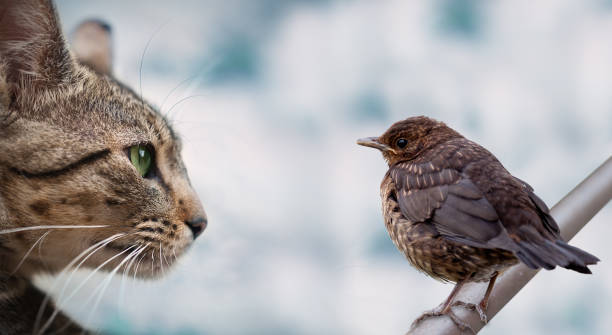by Lena DeTar, DVM, DACVPM, DABVP-SMP
Millions of birds across the world have been killed or depopulated due to the current Highly Pathogenic Avian Influenza (HPAI H5N1) pandemic. A new development in this round has been the impact on cattle (first reported in 2024 by a group including Cornell virologists, see this CDC summary), who until now, have not been known to get the flu. Researchers figured out what was affecting the cows partly through the discovery of influenza in deceased cats from the same dairy.

While catastrophic for the dairy industry, less widely reported is the impact of this outbreak on cats. Since early 2024, there have been around 50 cases reported in the U.S. Only a handful of cats have been identified as having HPAI while still alive: symptoms appear to be severe and primarily neurologic, including ataxia, circling, and depression, with a rapid decline despite significant supportive care– a good differential in these cases is rabies. Some cats show mild to severe respiratory signs. Survival is rare.
At the moment, affected cats appear to be infected by directly ingesting raw milk or raw food diets. Wild carnivores like foxes ingesting wild birds that die from HPAI are known to be similarly affected, one dog in Canada was reportedly sickened and died in the same manner.
What does this mean for shelters and community clinics?
1) Be vigilant for cats exhibiting neurological signs. Contact your veterinarian as soon as possible. As this may be difficult to distinguish from rabies and prognosis generally seems poor, euthanasia and submission for diagnosis of suspect cases is likely to be appropriate for most shelter cats. HPAI and rabies are both reportable diseases.
a) Shelters should consider asking about raw food diet or raw milk exposure at intake.
b) If a cat must be maintained in the shelter for legal reasons, or is hospitalized according to owner’s wishes, isolate away from all other cats. Wear PPE (esp gloves, smock and face mask) for all handling activities. Submission of urine to a state diagnostic lab such as Cornell’s AHDC for influenza testing may be more helpful than submitting respiratory swabs; EDTA whole blood and/or feces may also be requested. Anticipate disease progression. After death, whole bodies can be submitted for diagnosis. Contact the diagnostic lab, Cornell’s Veterinary Support Services or our shelter medicine program (sheltermedicine@cornell.edu) for further guidance if needed.
2) Do NOT feed raw food diets or unpasteurized milk to shelter animals. Prevent foster parents from feeding raw food to shelter animals (and encourage them not to feed raw food to their own pets.) Counsel owners not to feed raw food. Immediately remove dead birds or wild mammals found on shelter or hospital premises using appropriate PPE.
a) a devastating Korean shelter-wide HPAI outbreak in 2023 was related to feeding contaminated commercial raw food
3) For TNR operations, be aware that cats living on poultry or dairy farms may at higher risk. Consider separating these cats from others while they are at your clinic out of an abundance of caution. Wear PPE when handling community cats. Keep cat colony managers informed and have them report suspicious deaths.
While at the moment the primary route of feline HPAI transmission appears to be through ingesting infectious materials, influenza is a virus known for reassortment and mutation. Respiratory spread may become possible. In previous shelter-wide avian-sourced feline influenza outbreaks, human spread was documented. Increased awareness, attention to PPE, and swifter patient management can decrease spread, which decreases opportunities for concerning mutations.
For more information, please see below:
https://www.avma.org/resources-tools/animal-health-and-welfare/animal-health/avian-influenza/avian-influenza-h5n1-cats
https://www.wormsandgermsblog.com/
and
The University of Wisconsin webinar can be viewed here:
Source: University of Wisconsin – Program for Shelter Medicine and Community Engaged Care

